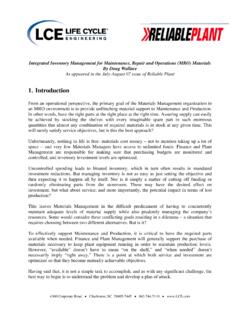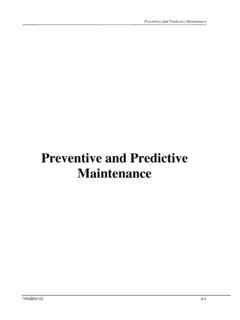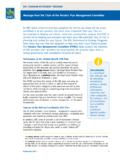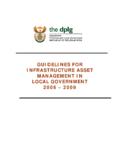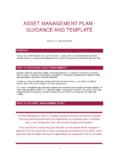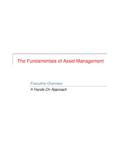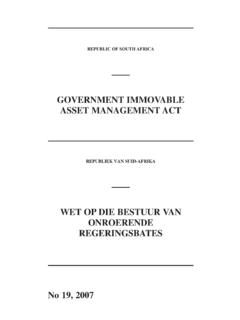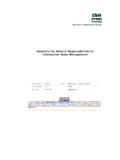Transcription of june/july15 - LCE
1 june / july15 UPTIME MAGAZINE june /JULY 2015 15 AMAsset Managementsset management plans form the cornerstone of an effective asset management system. The recently released ISO55000 series of standards for asset management clearly defines the importance of asset management plans (AMPs) by indicating that they provide the road map for achieving value from physical assets by optimizing cost, risk and perfor-mance across the asset s lifecycle. AMPs define the implementation activities necessary to realize an organization s asset management objectives, which translate the strategic intent of the company. The relationship and interdependencies of asset management policy, strategy, objectives and planning to achieve those objectives clearly demonstrate how important organizational alignment is to the creation of asset management ManagementCreating Value From Physical Assetsby Mark RubyDeveloping A s s e t management Plans46june/july 15A4767891670452347678916704523 Getting StartedCompliance versus PerformanceEven though ISO55000 has established many of the criteria for creat-ing AMPs, it is not necessary to approach this from a standard compliance perspective.
2 Many organizations are deciding to improve how they manage assets in order to achieve performance gains while postponing the compli-ance decision. Most companies al-ready maintain other ISO certifications and fully recognize the level of com-mitment necessary to seek certifica-tion. Short of a compelling business case for investing in the compliance journey, they are content to reap the performance gains without necessari-ly addressing all the management sys-tem aspects. This decision may impact the overall approach to creating AMPs and should be considered early Definition and SelectionDefining assets that can then be filtered through a selection process may not be as straightforward as it seems. From an expanded view of asset management , there are different levels at which an asset can be managed. At a foundational level, assets are viewed individually. This is the simplest and most easily understood approach. Assets also can be defined and viewed in terms of systems.
3 Examples of asset systems include networks, production lines, or facilities systems ( , HVAC, wastewater, compressed air, etc.). And finally, a third expanded view can define asset portfolios. Ex-amples include classes of oil rigs, business units, real estate and municipal on how you define assets, they can then be selected for plan de-velopment. A defined selection process is the most critical of all concepts in asset management . Assets should be selected based upon their criticality and defined risk to the value stream. A risk-based asset management approach should be utilized that includes a defined process for classifying, analyzing, controlling and measuring the effectiveness of the operating and equipment maintenance a pure process perspective, asset definition and selection are most likely an outcome of the strategic asset management plan (SAMP) and the establishment of asset management objectives. The point is to maintain the link-age for achieving organizational objectives within the asset management AMP Maturity LevelsAnother important getting started activity involves de-termining the approach to data collection and analysis.
4 As shown in Figure 1, the commitment to establishing an asset management system capable of providing the necessary information to construct advanced AMPs is often character-ized as a true continuous improvement simplest way to begin is to gather all existing data and analyses and start constructing the plan . Where data is required but does not exist, use organizational experience and judgment. Fill knowledge gaps with documented as-sumptions. This approach enables AMPs to be constructed quickly. Implementation momentum builds sooner as the organization develops the necessary awareness and desire required to sustain the new way of doing business. One dis-advantage to this simple approach is that plans result in a lower level of reli-ability, with the potential for suboptimal alternate approach requires the organization to perform a gap analy-sis against its existing capabilities and develop a tactical implementation plan for closing the gaps prior to beginning the preparation of the asset manage-ment plans.
5 This approach requires additional time and resources, but the data and analysis are more complete and the quality of the decision-making is can be benefits in develop-ing the first AMP as an interim plan as quickly as possible using existing infor-mation. It helps the organization under-stand the strengths and weaknesses of current asset management practices and identify priorities for developing future plans. It can also avoid allocating excessive resources for data collection before the needs are fully of how an organization decides to proceed, it is certain that the maturity level of the AMP will evolve and improve over time. The AMP devel-opment process will identify capability gaps and opportunities for improve-ment that must be systematically addressed via a continuous improvement loop. As the sophistication of the asset management system progresses, so will the maturity level of the asset management the PlanAn asset management plan defines the activities that will be implement-ed and the resources that will be applied to meet the asset management objectives and, consequently, the organizational An asset man-agement plan provides the direction to and the expectations for an individual asset , or for a portfolio, group, or class of management plans should be developed to appropriate time hori-zons for the The time horizons should meet the organization s needs and take into account the organization s period of responsibility and the life of its this in mind, an AMP template will help you define the specific activities, resources and scheduling required for an individual asset or a grouping of assets to achieve the organization s asset management objectives.
6 The maturity level of the AMP and the sophistication of the asset management system may impact which sections of the plan are prioritized over others. Here are the recom-mended sections your AMP template should include: asset management plan OverviewThe overview section identifies the assets within the plan , how the performance of the assets connects to orga-nizational objectives, the stakeholders and connectivity to other plans or standards. A brief summary of covered assets is also of ServiceA key aspect of asset management planning is to match the level of service assets provide to customer expectations. It provides the balance between the cost to deliver and the level required. Specific levels of service include cost, efficien-cy, quality, quantity, reliability, safety and level of service section may include a description of how organizational goals and regulatory requirements im-pact service levels. Current levels of service and targeted The simplest way to begin is to gather all existing data and analyses and start constructing the plan .
7 LEVELS OF MATURITYF igure 1: asset man-agement plan devel-opment a journey not a destinationBeyond ISOA dvancedBasicInterim48june/july 15 AMAsset Managementlevels of service are necessary to identify gaps that must be addressed in other sections of the asset management DemandFuture demand provides details of forecasted growth and asset utilization. This section also describes demand drivers and how demand changes may impact assets, demand contingency planning and investment plan -ning necessary to meet the demand Lifecycle ManagementThis section should summarize how assets will be managed and operated at the agreed upon service level while optimizing total cost of ownership at an appropriate level of risk. This section is the most important part of the AMP and includes these subsections:Financial SummaryThis section should include and summarize all financial requirements re-sulting from the activities in the previous sections.
8 The financial summary represents an important link to other parts of the organization and estab-lishes the value of asset management to the organization by integrating the financial impact of the activities into the company s financial and strategic plans. The summary should include cash flow forecasts for one to five years and provide the necessary details on how expenditures are to be treated ( , capital versus expense) in order to determine optimal funding strategies and ImprovementThis section should summarize the current and future asset management practices and provide details on the planning and monitoring of the asset management plans and any improvements to asset management sys-tems. It should provide a demonstrated link back to the deficiencies noted in constructing the other sections of the asset management , Reviewing and Maintaining the PlanOnce the assets are selected and the approach defined, it is time to be-gin writing the asset management plan .
9 Two key points are to always keep the objectives in mind and to rely on the most current and complete data available. Where assumptions must be made, be sure to document those assumptions. In many cases, some sections of the template may provide summary data with references to the exact locations where the data or the analysis is maintained. For efficiency purposes, it is very likely that the AMP will include many such references to specific locations within the asset man-agement section of the AMP may be written by different subject matter ex-perts, but should be coordinated by a single point of accountability. The entire team should review the AMP for consistency and accuracy. It also may be helpful to have an independent party review the plan for additional insight and understanding. Finally, the plan should be viewed as a living document that is to be updated and maintained in accordance with the established Background Information Provides basic asset information, including age, size, capacity, performance, current con-dition, current value and asset information management Risk management plan Identifies risks that may affect service delivery.
10 Includes what corporate goal or objective is impacted by the risk, how the risks are identified, how the risks are evaluated ( , consequences, probability, detectability) and what risk mitigation plans are in Operating plan Includes trends, the decision-making process, defined operating strategies and methods to meet required service levels, how operating tasks are prioritized, risks associated with alternative strategies and forecasts of planned operating Equipment Maintenance Plans Includes trends, the decision-making process, defined maintenance strategies and methods to meet required service levels, how maintenance tasks are prioritized, risks associated with alternative strategies and forecasts of planned maintenance Recapitalization Plans and Strategies Outlines renewal expenditures, which include major work that does not increase the asset s design capacity, but restores, replaces, or renews an existing asset to its original Capital Planning and Strategies Describes a new investment, which creates a new asset that did not exist previ-ously.
